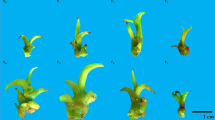Abstract
The conditions for efficient tuber production from suspension cultures of Pinellia ternata cells which is one of medicinal herbs were established and succinic acid in tubers propagated in vitro was determined. Leaf explants formed white nodular structures and off-white calluses at a frequency of 90.6 % when cultured on Murashige and Skoog medium supplemented with 0.54 μM α-naphthaleneacetic acid (NAA); however, this frequency declined substantially with increasing NAA concentration, up to 16.2 μM, at which the frequency reached zero percent. In combination treatments with 4.44 μM 6-benzyladenine (BA) and NAA, however, the frequency of white nodular structure and off-white callus formation from leaf explants did not decrease, even at 16.2 μM NAA. Suspension cultures of P. ternata cells were established from leaf-derived off-white calluses in MS liquid medium containing 5.4 μM NAA and 4.44 μM BA. Upon plating onto MS basal medium, over 90 % of cell aggregates gave rise to microtubers and developed into plantlets. Regenerated plantlets were transplanted in potting soil and grown to maturity in a growth chamber, with a survival rate of >90 %. The highest succinic acid content in suspension culture-derived microtubers was 45 g/kg of extract. Compared with wild P. ternata medicinal tubers, the succinic acid content was very similar. The in vitro P. ternata microtuber proliferation system established in this study is thus an efficient alternative for the mass production of medicinal tubers.





Similar content being viewed by others
Abbreviations
- BA:
-
6-Benzyladenine
- HPLC:
-
High performance liquid chromatography
- MS:
-
Murashige and Skoog
- NAA:
-
α-Naphthaleneacetic acid
References
Bown D (1995) Encyclopaedia of herbs and their uses. Dorling Kindersley, London
Chen CC, Gau TG, Tsay HS (1989) Studies on the callus formation and plant regeneration of Pinellia ternata. J Agric Res China 38:30–41
He Y, Zhu C, He M, Hao S (1996) Protoplast culture and plant regeneration of Pinellia ternata. Plant Cell Rep 16:92–96
Iwasa M, Iwasaki T, Ono T, Miyazawa M (2014) Chemical composition and major odor-active compounds of essential oil from Pinellia tuber (dried rhizome of Pinellia ternata) as crude drug. J Oleo Sci 63:127–135
Ji X, Huang B, Wang G, Zhang C (2014) The ethnobotanical, phytochemical and pharmacological profile of the genus Pinellia. Fitoterapia 93:1–17
Jo JE, Lee AY, Kim HS, Moon BC, Choi G, Ji Y, Kim HK (2013) Content comparative analysis and classification for Piniellia ternate, P. pedatisecta and Typhonium flagelliforme by HPLC-PDA analysis. Kor J Herbol 28:95–101
Kim SW, In DS, Tae KH, Liu JR (2005) High frequency plant regeneration from leaf-derived cell suspension cultures of Pinellia tripartita (Blume) Schott. Plant Cell Tiss Organ Cult 80:267–270
Kim YJ, Shin YO, Ha YW, Lee S, Oh JK, Kim YS (2006) Anti-obesity effect of Pinellia ternata extract in Zucker rats. Biol Pharm Bull 29:1278–1281
Kim JA, Moon HK, Choi YE (2013) Microtuber formation from in vitro Codonopsis lanceolata plantlets by sugar. J Plant Biotechnol 40:147–155
Kitamura S, Murata G, Koyama T (1980) Colored illustrations of herbaceous plants of Japan (Monocotyledon). Hoikusa Pub Co., Tokyo, p 196
Kurata K, Tai T (1998) Quantitative analysis of anti-emetic principle in the tubers of Pinellia ternata by enzyme immunoassay. Plant Med 64:645–648
Lee BK, Cho TS (1987) Experimental studies on pharmalogical action of Banhahubagtang, a combined preparation of oriental medicine. Kor J Pharmacogn 18:14–25
Liu Y, Liang Z, Liu J (2010a) Use of protocorm-like bodies for studying alkaloid metabolism in Pinellia ternata. Plant Cell Tiss Organ Cult 100:83–89
Liu Y, Liang Z, Zhang Y (2010b) Induction and in vitro alkaloid yield of calluses and protocorm-like bodies (PLBs) from Pinellia ternata. Alkaloid yield of in vitro tissues from Pinellia ternata. Vitro Cell Dev Biol Plant 46:239–245
Murashige T, Skoog F (1962) A reversed medium for rapid growth and bioassays with tobacco culture. Physiol Plant 15:473–497
Nagai T, Kiyohara H, Munakata K, Shirahata T, Sunazuka T, Harigaya Y, Yamada H (2002) Pinellic acid from the tuber of Pinellia ternata Breitenbach as an effective oral adjuvant for nasal influenza vaccine. Int Immunopharmacol 2:1183–1193
Tsay HS, Gau TG, Chen CC (1989) Rapid clonal propagation of Pinellia ternata by tissue culture. Plant Cell Rep 8:450–454
Wang J, Wang Q, Wang J, Lu Y, Xiao X, Gong W, Liu J (2009) Effect of different plant growth regulators on micro-tuber induction and plant regeneration of Pinellia ternate (Thunb) Briet. Physiol Mol Biol Plant 15:359–365
Xu T, Zhang L, Sun X, Tang K (2005) Efficient in vitro plant regeneration of Pinellia ternata (Thunb) Breit. Acta Biol Crac Ser Bot 47:27–32
Yoo CY, Lim HT (1997) Effect of thidiazuron on the formation of micro-tubers and plantlet regeneration of Pinellia ternata. Korean J Med Crop Sci 5:21–27
Acknowledgments
This work was supported by a grant from the KRIBB Research Initiative Program and by a grant (K14418) to SWK from the KIOM. We also greatly appreciate the supply of Pinellia tubers from the KIOM.
Author information
Authors and Affiliations
Corresponding authors
Additional information
E. Y. Jie and Y. B. Ryu contributed equally to this work.
Rights and permissions
About this article
Cite this article
Jie, E.Y., Ryu, Y.B., Choi, S.A. et al. Mass propagation of microtubers from suspension cultures of Pinellia ternata cells and quantitative analysis of succinic acid in Pinellia tubers. Plant Biotechnol Rep 9, 331–338 (2015). https://doi.org/10.1007/s11816-015-0369-0
Received:
Accepted:
Published:
Issue Date:
DOI: https://doi.org/10.1007/s11816-015-0369-0




